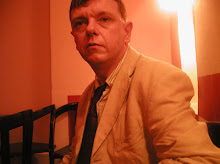See the article here
Taking a photograph in a public place has become the quickest way to attract police attention, as increasing numbers of photographers can verify. But now it has emerged that anti-terrorism officers are uneasy about a far less sophisticated piece of surveillance technology: the watercolour brush and canvas.
Liam O'Farrell, an artist who exhibited at this year's Royal Academy summer show, has described how he had been questioned and searched by police twice inside a week while painting a scene close to City airport in east London.
The artist contacted the Guardian following a series of incidents in Britain in which photographers, tourists and students were stopped under anti-terrorism laws.
The situation was highlighted in last Saturday's Guardian when a reporter, Paul Lewis, described being questioned within two minutes of taking photographs of the Gherkin building in the City of London.
In a similar spirit of inquiry, Lewis went to the London Eye, central London, today armed with an easel, canvas and acrylic paints.
What O'Farrell called, perhaps inevitably, his "brush with the police", began when he set up his equipment on a grass bank adjoining a public road just south of City airport. With his back to the complex he set about painting a composite scene of terrace houses and the Tate & Lyle sugar factory a few streets away.
Inside half an hour two Metropolitan police officers from the specialist unit based at the airport arrived in a patrol car and demanded to know what he was doing, saying he had been spotted on a CCTV camera.
"I told them, 'I'm hardly a terrorist, I'm watercolouring'. One policeman said, 'you're not painting the airport, are you?' I told him I was painting the sugar factory. He said 'no one paints factories'. I told him Lowry painted loads of factories and made a mint. He got a bit touchy then."
For 15 minutes, O'Farrell said, one officer checked his identification on a radio while another searched his bag. "They said I had 'weird paraphernalia' with me. I said 'it's a flask of coffee and an iPod'."
O'Farrell said he had returned to the same spot a week later to complete the work and was interrogated again, by two other officers.
"I told them I was just doing a watercolour of the sugar factory. One of them said 'no one does watercolours of factories'. I told them about Lowry – it was groundhog day. It was extraordinary.
"Then one said 'I can see what you're doing now, I'd be a bit more concerned if you were painting the airport'. I remember from my art history that centuries ago in China artists were murdered in case they [painted] maps and roads. But in the days of digital photography I hardly think a watercolourist painting an airport would be some sort of international threat." The experience left him baffled. "I've been painting in Moscow, in Vietnam, Ukraine, and all I get round me are bunches of kids. If the police come by they're just curious about the painting. It's extraordinary what happened to me."
The incident took place in the summer of 2007, O'Farrell said, and he was prompted to write after hearing about recent events.
A spokesman said the Met's assistant commissioner, John Yates, had reminded officers last week that they should not stop photographers without reason. "Anyone could imagine why an airport is seen as a sensitive site, but we are aware that there are issues of communication with officers about what they can and can't do, which is why John Yates has taken these measures," he said.
Today the advice was seemingly being heeded. The Guardian's reporter spent a couple of hours creating his rendition of the London Eye on a winter afternoon, and, barring a polite request from a security guard to move to a different section of the riverside thoroughfare, received no official attention whatsoever. The only other interest came from tourists keen to see the work's progress
Subscribe to:
Post Comments (Atom)


No comments:
Post a Comment